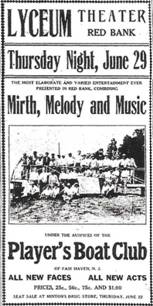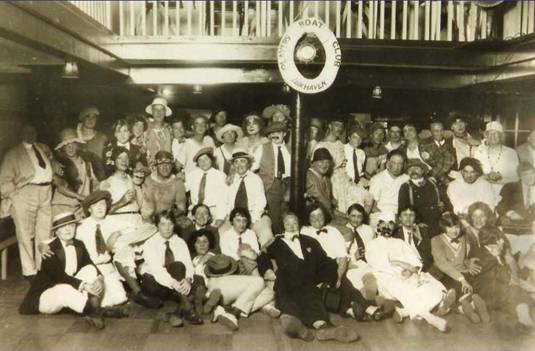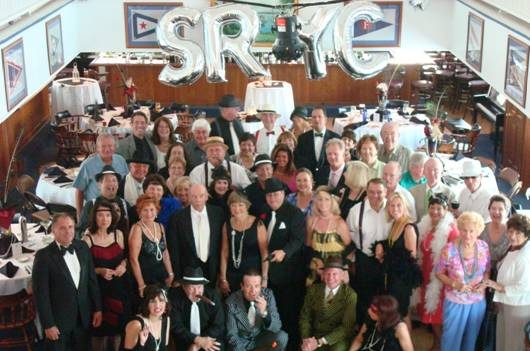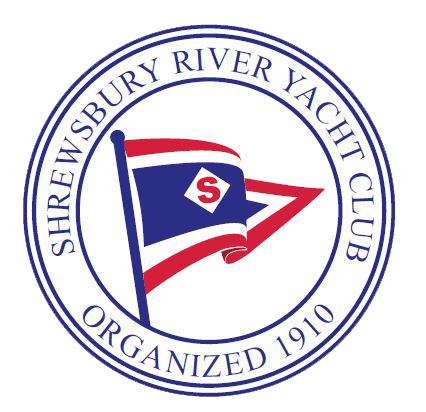It Started With
The Players Boat Club
By Mark Lockwood, PC, SRYC Historian & Ronney Subarsky, PC
The Shrewsbury River Yacht Club is steeped in a rich and colorful past that is perhaps unique among yacht clubs. Not only were its founding members boating enthusiasts but celebrated theatrical people as well. At the turn of the century, the village of Fair Haven was known as the place “on the beautiful Shrewsbury where Broadway comes to rest after a hard season of playing the boards.” A colony of some seventy-five vaudevillians took summer residence in the cottages and hotels around Doughty Lane and Kemp Avenue and by the end of the first decade of the new century, these actors would come to dominate the town’s social life.
The players’ public and charitable benefactions were many. Performers at the July 1902 benefit for the actor’s home included future Club members, including Burns, Evans, and North. The Players Boat Club and its members were among the earliest and most ardent supporters of the Fair Haven fire company. Indeed, the actors’ support predates the Club’s founding. The benefit show they put on for the firemen on June 21, 1905, organized by well-known theatrical manager Frank Martineau, was described by the Register the following week as “one of the best entertainments of its kind ever given in the town.
In 1906, reporting on the Firemen’s Fair, the Register noted on August 1, “A good many actors and actresses summer at Fair Haven. Many of them own summer homes there and they take life easy during their vacations from the stage. They are a good-natured, happy, public-spirited lot of people and they turn in and help every project of a public nature which comes up in that neighborhood. They helped the fair in many ways and they were as active as the firemen themselves in making the affair a success.” In 1907, the pre-Club vaudevillians gave a benefit performance for Eugene Wellington, who was ill in New York. The players had a tie to the spiritual world after they developed a close relationship with St. James Roman Catholic Church in Red Bank.
Club performers and participation comprised one of the most appealing features of the 1912 Firemen’s Fair. The Register reporter noted on July 31, 1912, “The infant borough has a large actors’ colony. These people, although residents of the place only a few months, take a big interest in the welfare of the town and during last week they were as active as the natives in aiding the firemen.” Their nightly minstrel shows included some of the best talent in the country, players who offered services that could not have otherwise been obtained for less than $1,500 per night. The roster was filled with Club members, future longtime stalwarts.
Their ten-act vaudeville show at the Empire Theater on July 17, 1913, opened that year’s St. James Fair. The performers included Nelson, Otto, Lockwood, McAllister, and Cantwell, while Lew hunting served as stage manager. The St. James’ pastor, the Reverend James A. Reynolds, became the only non-performer on the rolls when the Club bestowed on him honorary membership in 1912.
The Clubhouse
It was a large and social group that soon found itself in need of a place to gather. So they held a meeting in a barn behind the home of Tony Hunting on the comer of River Road and Doughty Lane and decided to buy a houseboat that would serve as their clubhouse.
As reported in the Red Bank Register on June 18, 1910, “On June 4, 1910, the Players’ Boat Club held its first meeting, when a constitution and by-laws were adopted. The home of the club is to be at Fair Haven, N.J. The following were elected to office: Tom Morrissey, commodore; Tony Hunting, vice-commodore; Ernest Otto, secretary, and Frank Martineau, treasurer.
The fleet consists of the sloop “Isabella” (J. Evans); launches “Never Do” ( T. Mooissey); “Squaw” (J. Mack); “Mary” (C.Nelson); “Sis” (Ted Evans); “Wee Mack” (Tad Dick Hume); “Rummey” (Jas. Tenbrooke); “Linda” (A. Muller); “Bob” (Tony Hunting); and the sloops “Nancy II” (Ralph Smith); “Little Jake” (J. Carron); “Little Bob” (Tony Hunting). The club has purchased the houseboat “Opal,” at present moored off Harry Blocksom’s property on the Shrewsbury River front.
A suitable houseboat was located in Red Bank, but the club treasury was insufficient to cover its purchase. Fortunately, there was a readily available solution. They decided to put on a show. The troupe marched through the streets of Red Bank in an open car motorcade that ended at the Frick Lyceum – a stage then located where the tennis courts are now in Marine Park. The show was a success and raised the $250 necessary to purchase the houseboat and tow it to the site of the current clubhouse.
True to their calling, they picked an auspicious occasion to celebrate the opening of their “Players Club” and it was July 4, 1910. Membership was strictly limited to theatrical folk, and the greats of the era were members and frequent visitors. While Al Jolson and Eddie Cantor were occasional guests, Annie Hart was the resident celebrity. A famous Ziegfield star, Annie Hart was affectionately known as the “Sheriff of Fair Haven,” and the press covered “Players Club” parties with as much dedication as they did her Broadway career.
The Players Boat Club emerged as the focal point of these players’ social structure. The clubhouse, in addition to serving as their headquarters, became a place to draw in an invited public to demonstrate to the rest of the world that the players had standing and stature. The actors who had boats, probably relatively few, could even use the club as a base for plying the local waters.
As social life thrived in the tiny Players Club, it soon became apparent that a larger clubhouse was needed. A second houseboat was located in Coney Island Creek. It was purchased for approximately $2,500 and towed from New York to Fair Haven where it spent the first winter in Fourth Creek just off Battin Road. The new clubhouse was moved to its proper site in the spring and the original was converted into a bungalow and moved to Elm Street. The second houseboat was once a chain ferry, and it had undergone extensive remodeling that included the construction of two second floor bedrooms and a heating plant. One of the bedrooms was abandoned in favor of a kitchen, and a balcony was added.
As mentioned in the Red Bank Register on June 7, 1922:
“FAIR HAVEN ACTOR FOLKS EXPECT TO START SOON
They will build on the Hoagland Property on the River Bank at Fair Haven-Club Members to Do Much of the Work Themselves
A new clubhouse will be started in a short time by the Player’s boat club of Fair Haven on land which the club bought last winter from the bag- land estate on the river bank at Fair Haven, at the foot of Doughty’s lane. The property has a frontage of seventy feet on the river and it is ninety feet deep. The club, which is composed of actors and actresses, will spend about $5,000 for the new building, but this will not represent its true value, for a great deal of work will be done by the club members without charge to the club. Some of them are handy with masons’ and carpenters’ tools, and those who are not will help cut down the expenses by doing lifting and lugging jobs. Arthur E. Smith of Fair Haven is the Contractor.
The floating clubhouse which is now used by the play actor folk will be moved ashore and made into part of the new clubhouse. Where the floating clubhouse is now located will be a large dock. About thirty actors and actresses live at Fair Haven and this number is augmented to 100 or more when the vacation season is at its height. The club is preparing for its annual benefit performance at Red Bank and for a number of other events.
Among the actors who joined the theatrical colony last week are Thomas “Scream” Welch and Charles Kelly. They came down from New York in their motor boat “Big Scream,” which is now anchored in Capt. Charles P. Irwin’s basin at Red Bank. The boat is one of the largest and best equipped in the North Shrewsbury, and its owners for a number of seasons past have spent their summers at Red Bank and Fair Haven. They are managers of the United booking association for Keith Vaudeville.”
The current clubhouse, designed by noted NJ architect Ernest A. Arend and built in 1929, is one of New Jersey’s oldest minimally-changed, purpose–built clubhouses. It was erected on pilings 110 feet from the shoreline and while substantial improvements have been made to dockage and decoration, the basic structure remains quite similar to the houseboat from which it was designed.
As mentioned in the Asbury Park Press on November 6, 1932, many “Notable figures have been visitors at the club and taken part in its performances. Many of them are honorary members. Among the number might be included: Irving Cobb, Will Rogers, James J. Corbett, Billy B. Van, Al Jolson, Eddie Dowling, Julian Eltinge, James Barton, Jim Thornton, Annie hart, Charles Ross, Dorothy Jordan, Charlotte Greenwood, Reginald Denny, Ben Bernie, Lydia Barry, Charles Grapewin, Jack Norworth and a host of others.”
Over the next two decades, vaudeville, their performance calling of choice, would fade, and so would their careers and their numbers in the community. The Club, however, retained its vitality over many more decades, in large part by chance when investors were admitted as members following a storm that required the major expense of a new clubhouse. However, the Club also experienced an orderly succession of the generations. In the process, a new boating group would carry on the players’ social traditions while transforming their club.
Meanwhile, talking movies were steadily eroding the popularity that vaudeville had enjoyed for these many years, and little by little the Players membership thinned. By 1939, the club could no longer enforce its “Players Only” membership requirements, and a traditional boating orientation developed. It was then the club was reorganized and incorporated as the Shrewsbury River Yacht Club. It had two boating members and dues were ten dollars.
While the generational transfer from the Players Boat Club to the Shrewsbury River Yacht Club was relatively smooth and had numerous connecting ties, the two groups represented distinct principal operations. Notwithstanding this organizational sea change, the critical link is the social ethos that bound the players as a tight knit group. That quality remained in the clubhouse. Indeed, the personal ties that link the members of today’s Shrewsbury River Yacht Club are as strong as or even stronger than the Players.
The club has changed dramatically as how we know it present day. Prior to 1959 the bar was located on the east side of the building in the shape of a skiff and to the north of the edifice was a ramp and a float.
In 1952 a pier was constructed which was extended in 1958 to its present length. A year later the bar was moved from the Eastside of the club close to its present location.
Eight years later, air conditioning was installed and the picture windows which give us the beautiful view of the river replaced the small paned windows.
In order to extend the main room of the clubhouse, the former porch was enclosed with our current bar. A porch was added above the new addition.
The Shrewsbury River Yacht Club has enjoyed many significant events over the course of its history. One of its finest moments, however, occurred during the celebration of the nation’s Bicentennial. The SRYC was designated by the Operational Sail committee as the host club for two of the visiting foreign “Tall Ships.” The Nippon Maru of Japan and the Gloria from Colombia were anchored in Sandy Hook Bay, and the officers and student crews from each ship were the honored guests of the club. With dignitaries in attendance from Diplomatic Missions to the UN, the glamour and pageantry of this celebration was in keeping with the general lifestyle of the original Players Club. Ironically, the date was July 4, 1976, the country’s 200th birthday and the 66th birthday of the “Players.”
Op Sail 1986 brought together sailing ships from all over the world to celebrate the 100th Birthday of the Statue of Liberty. The 1992 Columbus Op Sail celebration once again brought together the sailing ships of the world. SRYC hosted the Amerigo Vespucci with a gala for officers and crew.
In 1990 the interior of the club was refurbished. Dark plastic paneling installed in 1966 was removed and replaced with beautiful cherry wood paneling. In addition, custom-made drapes completed the decor.
In 1992 research was commenced to locate pictures of all past commodores which culminated in two plaques being unveiled at a clubhouse reception in September 1993. All past commodores and their families were invited with some guests coming from Oregon and Florida.
The club has weathered many storms such as Hurricane Donna on September 12, 1960, bringing 6″ of water into the clubhouse. On December 11, 1992, the “Storm of the Century” hit the eastern seaboard with major devastation to the shore area. The main dock was completely destroyed but fortunately the interior of the club was spared. Work parties started earlier than usual to restore the club, which was accomplished for the May opening. The sprinkler system was installed in 1993. Super Storm Sandy in 2014 tested the resilience of the clubhouse and docks and the mettle of the members. Floodwaters necessitated the replacing of paneling, electrical wiring and furniture. The SRYC survived the ordeal and continues to thrive and live up to its Statement of Purpose.
In 1994 the Commodore’s Award was established to honor a member who showed exemplary club spirit by giving extraordinary time and effort to the club.
In 1995, a historical happening occurred when women were allowed to become members for the first time of the previous all male club.
In September of 2010, the Shrewsbury River Yacht Club celebrated its heritage by presenting a vaudeville show for its members and for the citizens of Fair Haven. Some 20 Club members reenacted the hay day of The Players Club in the 1920’s, performing dances, comedy skits and music composed by the likes of Cole Porter, Irving Berlin and George M. Cohan. Hosted by the “Spirit” of Tony Hunting (who was the Club’s commodore from 1915 to 1935), the audience was taken back in time to those days when the Club and the town of Fair Haven were the summer home for vaudevillians. History was relived through this one hour show, and as Tony Hunting stated at the start of the show, “This performance represents the spirit and flavor of those days gone by – the days when show business was king and the players were royalty.” Today, the Shrewsbury River Yacht Club (formerly The Players Club) stands as a reminder of that historic era 100 years ago.
Our History
By Mary T. Santry - Historian 1998
The Shrewsbury River Yacht Club – located on the North Shrewsbury River commonly called the Navesink – is steeped in a rich and colorful past that is perhaps unique among yacht clubs. Not only were its founding members boating enthusiasts but celebrated theatrical people as well. At the turn of the century, the village of Fair Haven was known as the place “on the beautiful Shrewsbury where Broadway comes to rest after a hard season of playing the boards.”
Led by New York Theater owner Tony E. Hunting & Henry Clay Minor, a colony of some seventy-five vaudevillians took summer residence in the cottages and hotels around Doughty Lane and Kemp Avenue. It was a large and social group that soon found itself in need of a place to gather. So they held a meeting in a barn behind the home of Tony Hunting on the comer of River Road and Doughty Lane and decided to buy a houseboat that would serve as their clubhouse. A suitable houseboat was located in Red Bank but the club treasury was insufficient to cover its purchase. Fortunately, there was a readily available solution. They decided to put on a show. The troupe marched through the streets of Red Bank in an open car motorcade that ended at the Frick Lyceum – a stage then located where the tennis courts are now in Marine Park. The show was a success and raised the $250 necessary to purchase the houseboat and tow it to the site of the current clubhouse.
True to their calling, they picked an auspicious occasion to celebrate the opening of their “Players Club” – it was July 4,1910. Tom Morrissey was elected its first President and his brother-in-law Tony Hunting served as Vice-President. Membership was strictly limited to theatrical folk, and the greats of the era were members and frequent visitors. While Al Jolson and Eddie Cantor were occasional guests, Annie Hart was the resident celebrity. A famous Ziegfield star, Annie Hart was affectionately known as the “Sheriff of Fair Haven” and the press covered “Players Club” parties with as much dedication as they did her Broadway career.

As social life thrived in the tiny Players Club, it soon became apparent that a larger clubhouse was needed. A second houseboat was located in Coney Island Creek. It was purchased for approximately $2,500 and towed from New York to Fair Haven where it spent the first winter in Fourth Creek just off Battin Road. Once wide and deep, this creek now would scarcely float a rowboat at low water. The new clubhouse was moved to its proper site in the spring and the original was converted into a bungalow and moved to Elm Street. The second houseboat was once a chain ferry and it had undergone extensive remodeling that included the construction of two second floor bedrooms, and a heating plant. One of the bedrooms was abandoned in favor of a kitchen and a balcony was added.
In 1930 the current clubhouse was erected on pilings 110 feet from the shoreline and while substantial improvements have been made to dockage and decoration, the basic structure remains quite similar to the houseboat from which it was designed.
Meanwhile, talking movies were steadily eroding the popularity that vaudeville had enjoyed for these many years and little by little the Players membership thinned. By 1939, the club could no longer enforce its “Players Only” membership requirements, and a traditional boating orientation developed. It was then that the club was reorganized and incorporated as the Shrewsbury River Yacht Club. It had two boating members and dues were ten dollars.
The club has changed dramatically to how we know it present day. Prior to 1959 the bar was located on the East side of the building in the shape of a skiff and to the North of the edifice was a ramp and a float.
In 1952 a pier was constructed which was extended in 1958 to its present length. A year later the bar was moved from the Eastside of the club close to its present location.
Eight years later, air conditioning was installed and the picture windows which give us the beautiful view of the river replaced the small paned windows.
In order to extend the main room of the clubhouse, the former porch was enclosed with our current bar. A porch was added above the new addition.
The Shrewsbury River Yacht Club has enjoyed many significant events over the course of its history. One of its finest moments however, occurred during the celebration of the nation’s Bicentennial. The SRYC was designated by the Operational Sail committee as the host club for two of the visiting foreign “Tall Ships.” The Nippon Maru of Japan and the Gloria from Colombia were anchored in Sandy Hook Bay and the officers and student crews from each ship were the honored guests of the club. With dignitaries in attendance from Diplomatic Missions to the UN, the glamour and pageantry of this celebration was in keeping with the general lifestyle of the original Players Club. Ironically, the date was July 4, 1976 the country’s 200th birthday and the 66th birthday of the “Players.”
Op Sail 1986 brought together sailing ships from all over the world to celebrate the 100th Birthday of the Statue of Liberty. The 1992 Columbus Op Sail celebration once again brought together the sailing ships of the world. SRYC hosted the AMERIGO VESPUCCI with a gala for officers and crew.
In 1990 the interior of the club was refurbished. Dark plastic paneling installed in 1966 was removed and replaced with beautiful cherry wood paneling. In addition, custom-made drapes completed the decor.
In 1992 research was commenced to locate pictures of all past commodores which culminated in two plaques being unveiled at a clubhouse reception in September 1993. All past commodores and their families were invited with some guests coming from Oregon and Florida.
The club has weathered many storms such as Hurricane Donna on September 12, 1960 bringing 6″ of water into the clubhouse. On December 11, 1992 the “Storm of the Century” hit the eastern seaboard with major devastation to the shore area. The main dock was completely destroyed but fortunately the interior of the club was spared. Work parties started earlier than usual to restore the club, which was accomplished for the May opening. The sprinkler system was installed in 1993.
In 1994 the Commodore’s Award was established to honor a member who showed exemplary club spirit by giving extraordinary time and effort to the club.
In 1995, a historical happening occurred when women were allowed to become members for the first time of the previous all male club.
May the coming years bring more good times.



